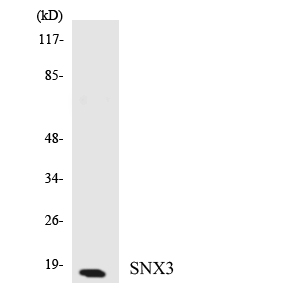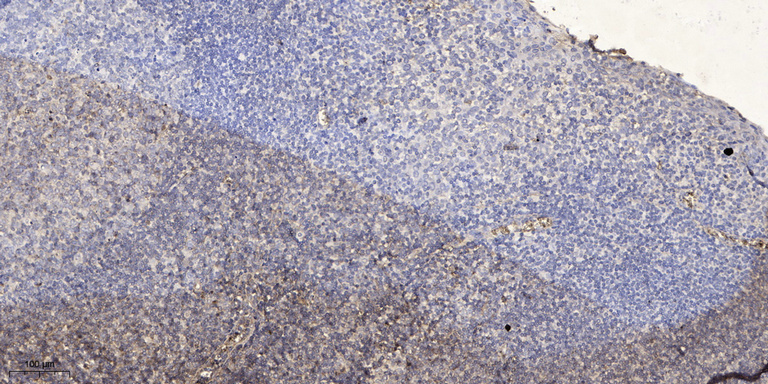SNX3 Polyclonal Antibody
- Catalog No.:YT4359
- Applications:WB;ELISA;IHC
- Reactivity:Human;Mouse;Rat
- Target:
- SNX3
- Fields:
- >>Endocytosis
- Gene Name:
- SNX3
- Protein Name:
- Sorting nexin-3
- Human Gene Id:
- 8724
- Human Swiss Prot No:
- O60493
- Mouse Swiss Prot No:
- O70492
- Rat Gene Id:
- 684097
- Rat Swiss Prot No:
- Q5U211
- Immunogen:
- The antiserum was produced against synthesized peptide derived from human SNX3. AA range:91-140
- Specificity:
- SNX3 Polyclonal Antibody detects endogenous levels of SNX3 protein.
- Formulation:
- Liquid in PBS containing 50% glycerol, 0.5% BSA and 0.02% sodium azide.
- Source:
- Polyclonal, Rabbit,IgG
- Dilution:
- WB 1:500-2000;IHC 1:50-300; ELISA 2000-20000
- Purification:
- The antibody was affinity-purified from rabbit antiserum by affinity-chromatography using epitope-specific immunogen.
- Concentration:
- 1 mg/ml
- Storage Stability:
- -15°C to -25°C/1 year(Do not lower than -25°C)
- Other Name:
- SNX3;Sorting nexin-3;Protein SDP3
- Observed Band(KD):
- 18kD
- Background:
- This gene encodes a member of the sorting nexin family. Members of this family contain a phox (PX) domain, which is a phosphoinositide binding domain, and are involved in intracellular trafficking. This protein does not contain a coiled coil region, like most family members. This protein interacts with phosphatidylinositol-3-phosphate, and is involved in protein trafficking. A pseudogene of this gene is present on the sex chromosomes. Alternative splicing results in multiple transcript variants encoding distinct isoforms. [provided by RefSeq, Jul 2014],
- Function:
- disease:A chromosomal aberration disrupting SNX3 may be a cause of microphthalmia syndromic type 8 (MCOPS8) [MIM:601349]. Translocation t(6;13)(q21;q12). Microphthalmia is a clinically heterogeneous disorder of eye formation, ranging from small size of a single eye to complete bilateral absence of ocular tissues (anophthalmia). In many cases, microphthalmia/anophthalmia occurs in association with syndromes that include non-ocular abnormalities. MCOPS8 is a very rare congenital syndrome characterized by microcephaly, microphthalmia, ectrodactyly of the lower limbs and prognathism. Intellectual deficit has been reported.,function:May be involved in several stages of intracellular trafficking.,similarity:Belongs to the sorting nexin family.,similarity:Contains 1 PX (phox homology) domain.,
- Subcellular Location:
- Early endosome . Cytoplasmic vesicle, phagosome . Colocalizes to clathrin-coated endosomal vesicles morphologically distinct from retromer-decorated non-branched endosomal tubule structures (PubMed:21725319) Colocalizes with EEA1 on nascent phagosomes in dendritic cells but competes with EEA1 for binding to phagosomal membrane (PubMed:23237080). In the case of Salmonella enterica infection localizes to Salmonella-containing vacuoles (SCVs) from which SNX3-containing tubules form 30-60 min after infection (PubMed:20482551). .
- Expression:
- Brain,Colon,Epithelium,Pancreas,Platelet,Skin,
- June 19-2018
- WESTERN IMMUNOBLOTTING PROTOCOL
- June 19-2018
- IMMUNOHISTOCHEMISTRY-PARAFFIN PROTOCOL
- June 19-2018
- IMMUNOFLUORESCENCE PROTOCOL
- September 08-2020
- FLOW-CYTOMEYRT-PROTOCOL
- May 20-2022
- Cell-Based ELISA│解您多样本WB检测之困扰
- July 13-2018
- CELL-BASED-ELISA-PROTOCOL-FOR-ACETYL-PROTEIN
- July 13-2018
- CELL-BASED-ELISA-PROTOCOL-FOR-PHOSPHO-PROTEIN
- July 13-2018
- Antibody-FAQs
- Products Images

- Western blot analysis of SNX3 Antibody. The lane on the right is blocked with the SNX3 peptide.

- Western blot analysis of the lysates from HUVECcells using SNX3 antibody.

- Immunohistochemical analysis of paraffin-embedded human tonsil. 1, Antibody was diluted at 1:200(4° overnight). 2, Tris-EDTA,pH9.0 was used for antigen retrieval. 3,Secondary antibody was diluted at 1:200(room temperature, 45min).



